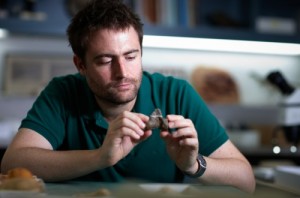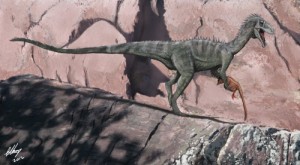Evidence of Ceratosauria – Ankle bone suggests that Ceratosaurs lived in Australia Too
A team of scientists led by researchers from the Museums Victoria (Melbourne, Australia) have announced the discovery of an ankle bone (tarsus) that suggests that a group of meat-eating dinosaurs not thought to have existed on the continent, may have been present after all. The ankle bone represents the first evidence in Australia of a group of theropods known as the ceratosaurs – it suggests that during the Early Cretaceous, Australia was a “melting pot” of Dinosauria diversity. The fossil bone, which measures just six centimetres wide was discovered near to the seaside town of San Remo, south-east of Melbourne back in 2006.
Dr Fitzgerald Examines the Ankle Bone
Picture credit: Museum Photographer Ben Healley
Dr Erich Fitzgerald, a palaeontologist at Museum Victoria, lead author on the scientific paper published in the journal “Naturwissenschaften” commented:
“Until now, this group of dinosaurs has been strangely absent from Australia, but now at last we know they were here – confirming their global distribution.”
Ceratosaurs
Ceratosaurs are a group of predatory theropods, mostly known from Jurassic aged strata from North and South America, Europe and Africa. As a group, the majority of genera are poorly known with only a few fragmentary fossil specimens representing a number of specimens. They shared the status of apex predators in many ecosystems with the much more common, and in most cases larger allosaurids. The taxonomic relationship between this group and other types of theropod is uncertain, it is likely that these creatures survived into the Late Cretaceous but this new Australian fossil find confirms that these creatures were present in Australia to at least around 125 million years ago.
An Artist’s Impression of the Ceratosaur
Picture credit: Brian Choo
Dr Fitzgerald stated:
“This discovery joins other widespread carnivorous dinosaurs now known to have lived in Australia – tyrannosaurs, spinosaurids and allosaurs.”
Dinosaur Ankle Bone
The discovery of an ankle bone, ascribed to the Ceratosauria improves the understanding of the distribution and evolution of dinosaurs in the eastern part of the super-continent known as Gondwanaland.
Dr Fitzgerald explained:
“It had been thought that isolation played a lead role in the formation of Australia’s dinosaur fauna. But the ceratosaur and other new discoveries show that several dinosaur groups were here. These dinosaur lineages date back to the Jurassic, 170 million years ago, when dinosaurs could walk between any two continents.”
This is not the first time an ankle bone has led scientists to re-think the predatory dinosaur population of Australia. A controversial interpretation of a fossil bone found in the Otway Range, near Melbourne Australia led some scientists to suggest that a type of allosaur had survived in Australia and was present hunting other polar dinosaurs around 106 million years ago. At just over five metres in length, this Allosaur was much smaller than its better known North American cousins who hunted the plains of the western United States in the Late Jurassic. This dinosaur, regarded as a “dwarf allosaurid” was scientifically named and described Allosaurus astragalus. This carnivore appeared in the “Walking with Dinosaurs” television series, it was featured in episode five – “Spirits of the Silent Forest”, that explored the fauna and flora of the polar forests of the Cretaceous.
A Close up of the Dinosaur Fossil Bone
Picture credit: Museum Photographer Ben Healley
With a focus on how the new ankle bone discovery helps shape current thinking on dinosaur geographical distribution, Dr Fitzgerald stated:
“So perhaps Australia’s dinosaurs represent those groups that achieved global distributions early in their history, before the continents split up. It’s the old age of their lineages – not continental isolation – which explains these dinosaurs’ presence in Australia. Apart from Antarctica, Australia has the world’s most poorly known dinosaur record – one of the last frontiers for dinosaur hunters. Although discovery rates are accelerating, we’re still in the early days of exploring which dinosaurs actually lived here. Each discovery has the potential to change what we know.”
Thanks to Karen Meehan of Museums Victoria for her assistance in helping to compile this article.
For models and replicas of ceratosaurs and other theropod dinosaurs: CollectA Age of Dinosaurs Popular Replicas and Figures.








Leave A Comment